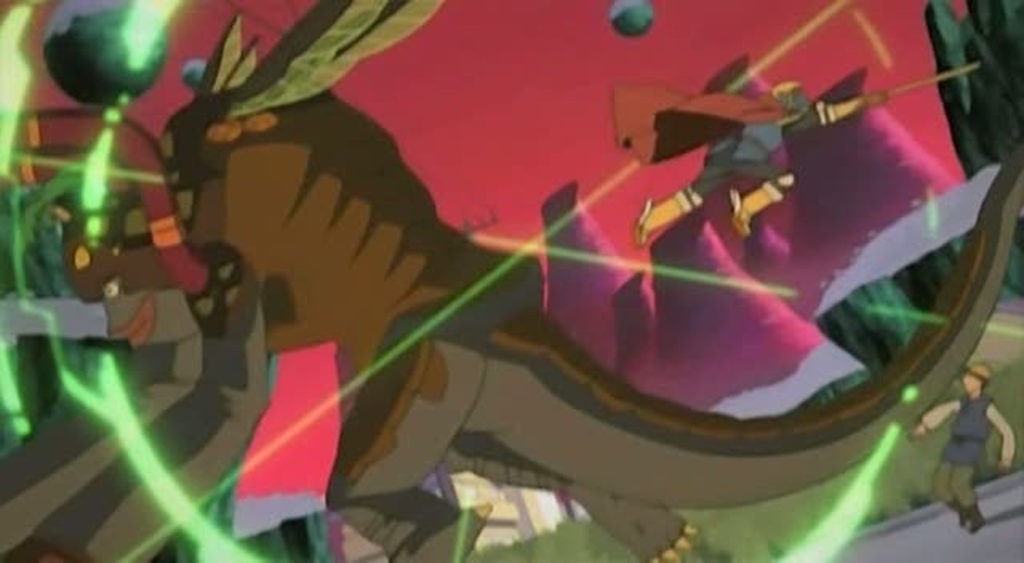After a whole lot of stories that could, to one degree or another, all be described using the adjective “grim”, the fifth episode of Paranoia Agent shakes things up a little bit, feinting towards comedy. It’s not exactly a laugh riot, mind you, but “The Holy Warrior” has a definite playfulness and even silliness to it that has not been seen in the series heretofore (and, I’d wager, won’t be seen again).
The episode is typical of a certain trope that comes up often in serialised television: the narrative pause. After four whirlwind plots of character development and world-building, the time has come for the series to draw a deep breath, if you will. Thus it is that the story of this episode consists, on the simplest level, of recap: describing the events in the show to this point, albeit from a different perspective.
In the full spirit of things, the episode kicks off with the local gossip: all around Tokyo, people are chattering about the arrest of Lil’ Slugger, though to say their conversations verge into the fanciful would be understating it. Though short, and presently overwhelmed by the most stylistically wide-ranging episode of the series yet, this sequence is a potent mixture of content and form: as we hear the gossip, we look at what I can only think of as slightly Impressionistic snapshots of the city – a slightly “off” representation that perhaps represents the curiously exhilarating feeling of elation and disappointment when a mystery gets solved.
The action then picks up seemingly about a day after the conclusion of “A Man’s Path” – the kid that Hirukawa arrested is now in the custody of detectives Ikari and Maniwa, bearing no apparent marks from what appeared to be a brutal beating. We find out that he’s named Kozuka Makoto, he’s an eighth-grader, and he’s apparently lost his mind. As he lays out his confession to the detectives, he spins a tale based almost entirely upon the character details found in the strategy guide to a video game RPG; taking that source material as his inspiration, Makoto has concluded that he is the Holy Warrior destined to destroy the Gohma that can take over the body of innocent people.
It’s been increasingly clear throughout the series to this point that Kon is systematically taking aim at various elements of popular culture, but “The Holy Warrior” represents something of a high water mark: for the first time, the episode itself takes on the aspect of the thing it’s critiquing. Makoto’s hallucinations – and despite Ikari’s cynicism, it’s quite hard to assume the boy is altogether bright enough to make this all up – specifically reference video games in every respect: from “Gohma” (a Legend of Zelda beast), to the appearance of turn-based combat selection and character status screens, to Makoto’s tendency to hoist his newly acquired items in the air as a fanfare plays (as with all video game parodies, the music also has a distinct Zelda flavor). The commentary isn’t subtle: the boy’s ability to respond to the real world has been corrupted by the much more godly powers accorded to him in virtual life, and so he casts himself and all of his actions according to the only thing that’s ever made him feel like a somebody.
Despite the serious-sounding message, “The Holy Warrior” consistently aims for absurdity rather than the mirthless character study of the series’ earlier episodes, mostly centered around the figures of Maniwa and Ikari. They essentially play the Laurel and Hardy roles, respectively: as Maniwa goes further down the rabbit hole, getting more and more entertained by his role in Makoto’s delusion, Ikari responds with thin-lipped impatience, in a line reaction shots that never fail to elicit a titter, if not an outright laugh. In this, “The Holy Warrior” rises above the danger of being just a Millennium Actress do-over.
Even the animation does its part to add to the humor: eschewing the realism of the rest of the series, Makoto’s fantasy is rendered with the broad movements and simple lines of more juvenile anime than Kon tended to practice. It’s a subtle thing, but it adds greatly to the totality with which the episode digs into the crudity of Makoto’s dreaming.
It’s also surely not a coincidence that the one victim that Makoto doesn’t mention, and the one character who doesn’t confirm the attacker’s identity, is none other than Tsukiko, whose beating was the start of the Lil’ Slugger affair; and in fact she appears nowhere in “The Holy Warrior”, the first episode without her or Maromi. This is telling, and while neither Ikari nor Maniwa takes notice of it, the older, grumpier detective still has his doubts; and the episode ends with a promise that something major is about to happen, thanks to the re-appearance of an almost-forgotten minor character who probably isn’t so minor after all. This is another element of the “pause” episode in a serial: to re-assemble all the pieces and give us the tiniest tease of what is to come next. And in that spirit, I must provide a tease of my own, though I don’t know what it means: in this episode that does so much to remind us that the characters are in some way inspired by animals, Kozuka Makoto includes the word for “fox” in it – and in Japanese animal folklore, as in so many other countries, the fox is invariably regarded as a sly, wicked trickster.
